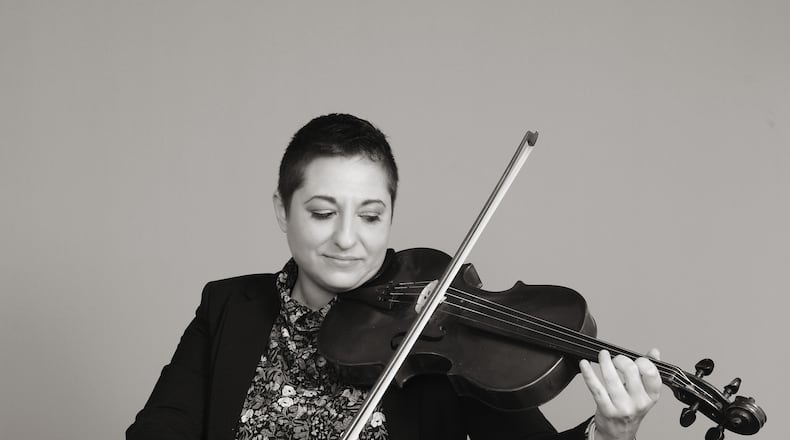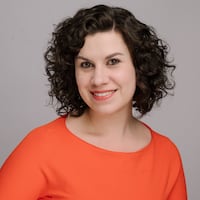Sofer’s first book, with MIT Press, called "Sex Sounds" partly analyzes electronic music history’s exclusion of works created by women and people of color. Sofer is working on a new book tentatively titled “Helmholtz’s Myograph” about German physicist Hermann von Helmholtz and his contributions to theory of hearing.
Sofer, 41, lives in Belmont with their 8-year-old daughter, a Golden Retriever named Harold and Petey the orange cat.
Home is a feeling
“Until I was 30 I never lived anywhere for longer than 5 years,” said Sofer.
Moving places didn’t end with adolescence. Sofer’s academic pursuits brought them to Wisconsin, Austria and Ireland — the latter where they lectured at Maynooth University and had their daughter — before ultimately settling in Dayton.
Is there a place they consider home?
“When you say ‘country’, I think America, the U.S. When you say ‘home’, I think of being at the beach in Haifa every day. I lived there from 11 through 17.”
At that point the family left Israel, where Sofer finished out their last year of high school in rural New York. It was a complicated time, right around 9/11, made more complex by what would become Sofer’s fugitive status.
Military service is generally mandatory for Israeli citizens upon reaching the age of 18. Though Sofer wasn’t born in Israel, they were required to serve under the logic that they had spent their formative years in the country. When they instead left, the Israel Defense Forces labeled them a fugitive.
“I had my placement, I was going to be in Israeli intelligence, a translator. But I left and didn’t do it. For 10 years I wasn’t allowed into Israel. My mom had cancer at the time and I couldn’t go see her.
“Now, there’s a war. When you’re listed as a fugitive, they don’t tell you what the consequence is. You hear these rumors — if you step off a plane they’ll arrest you or extort you. You don’t know.”
Conceiving rhythm
“Music theory is very old. We trace it back to Ancient Greece. It was very important in the Middle Ages, (linked to) mathematics, physics, astrology, astronomy. In America, it was only established in the Academy as a scientific degree in the 1960s.
“Music theory in the U.S. has been taught more or less the same since these degrees were codified. A couple years ago when I got here, they changed the curriculum to not just focus on composers from the 18th and 19th century (because) the only skills our students came out with were focused on that kind of music — Baroque, Classical, Romantic.
“Think about the kind of music you hear on the radio and jobs that are out there — you could be a sound engineer, a producer, a songwriter. You weren’t gaining any of those skills. We start with acoustics and go through (to) turntables and mixing. We talk about different ways of conceiving a rhythm and notation around the world, cycles that overlap between (say) Indian music and Detroit techno.
Bending time
“Music theory is conceptual. The point of using theory is to communicate something that you hear in the music. There was a music theorist, David Lewin, who said that music theory helps you listen better.
“We can bend time in ways that you can’t do in a music history class. If I’m talking about a chord, and I see it in music in different areas of the world, then I can jump from the 15th century to the 18th century and say, oh there’s that same chord, it’s doing the same thing. You abstract concepts from a lot of kinds of music so that you can come to a consensus on the term.
Credit: Contributed
Credit: Contributed
Designing sound
“I wake up in the morning and the first thing I have to do is feed the dog and the cat and take my daughter to school or camp. Then I’ll go teach. I’m fortunate that I was able to negotiate a teaching schedule within school hours.
“The courses start with learning how to use a computer to mix music with a digital audio workstation, or ‘DAW’. You learn all the physicality — how you plug in the microphone and speakers, how to use electricity. In the computer you do the EQ (equalization) and compression. That’s one class, and to me that’s really important.
“I have another course called Designing Sound where we talk about what we’re listening to in the environment. They’re not really listening to music, they’re going outside and listening to trains or, one time, I had a student submit (the audio of) a cow giving birth. They’re studying these soundscapes and reading alongside them.
“They read about different ways that cultures preserve themselves through sound. I give them original news footage from a nuclear bomb falling, and they have to transcribe it and make sound and narrate it in the way that it would have sounded (at the time). They have to know the tools and control them well enough to make it sound like it’s 1945.
“A lot of them are electrical engineering majors. Some students have coded video games you can play. Last year I had a student sonify a basketball in a basketball game, so you could hear where the ball was going. We do spatialized sound in the concert hall (Roger Glass Center for the Arts), so moving a sound around the room.
Practical applications
“My job right now as the (Music Technology) area coordinator is working to reach out to places to get internship pipelines. There are sound engineers who work at car manufacturing places — when you’re driving your car you don’t want to hear your engine, but you want to hear your music really well. How do you develop acoustics for that, what are the materials you need? They’re already using technology to identify Parkinson’s tremors. They discovered it was easier to identify the types of tremors or diagnose people based on the sound your hand makes.
“We have concerts all the time in the music department. I try to attend as many as I can. I’m curious because I’m invested in my colleagues and students. It’s also nice because you know they are there for you. Last year I helped coordinate music for Trans Day of Remembrance.
“We have ongoing conferences. In July I’m coordinating a one-week summer festival for deejays in Berlin. In October I’m going to Luxembourg to present research for my new book to the Society for the History of Technology.
Developing theories
“In the middle of all of that, we’re expected to read new articles, research, and develop new theories. About 1/3 of my hours during the week I’m in meetings for 2-6 hours about (for example) how how can we create a new type of material that can sense motion or sound but not be effected by heat.
“There’s a new research department, the Office of Academic Research. They started these communities of practice. I’m on two, one is Social Justice-themed that has partners from UD and the community. Another one is the artificial intelligence one, with all kinds of people. People detecting traffic patterns, people who work for the military, people who do ethics, educators, English professors. We talk about AI and we’re trying to work together to figure out how we can communicate to the administration of our university the most effective path going forward.”
Back home
Credit: Contributed
Credit: Contributed
Sofer picks up their daughter for violin lessons, gymnastics or swimming. They go to a nearby park with Harold.
“I love to cook. I try to balance it, I’ll cook or go out. I’m a work hard, party hard kind of person. I think Dayton has a lot of great night life. I love pinball so I like Canal Street. Barrel House is great. Grist is a lovely restaurant. I think Wheatpenny is my favorite over all.
“I play tennis three or four times a week at KTC. I’m on an informal beginner’s pickle ball league that meets once a month at a park.
“After tennis it’s basically bedtime. Sometimes I’ll watch or read something. I practice music every second I can. I have a piano and viola and guitar and accordion. I started piano when I was two and have a Masters of piano. In my head I’m preparing for some performance, but there’s no performance on the horizon.
“Fridays, in our music department, we have a weekly concert at the Roger Glass Center which is usually students (performing). Sometimes it’s visitors, faculty or a lecture. That’s always the highlight of my week. I finish my hard week, I have some music and then I feel good.”
Sofer participates in Art in the City through the Downtown Dayton Partnership on August 2, 2025. They will present their “Sounds of Dayton” sound walk with hands-on tutorials and a sound installation. More info at downtowndayton.org
To learn more about Daniele Sofer, visit www.shlomitsofer.com/about-me
About the Author




